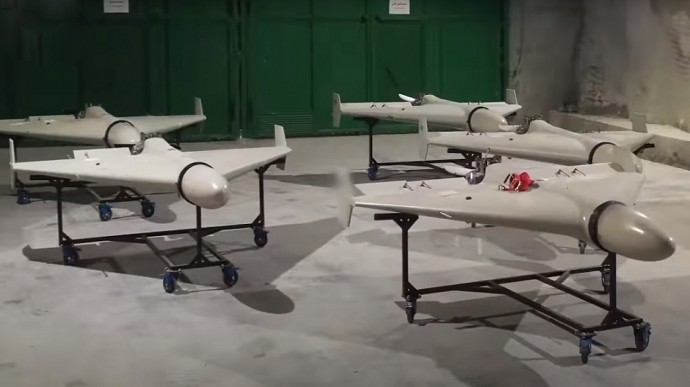
Shahed-136/photo from Yurii Butusov’s page
[For urgent updates please follow Ukrainian Freedom News on Telegram]
1. Shahed-136 is a barrage munition that flies and hits a target by the given coordinates. It is used as a long-range weapon for the same purposes as cruise and ballistic missiles, most of which are currently exhausted in stocks of the Russian army. A silent-moving drone, seen by radars and heard at a distance of up to 10 km, uses tactics of attacking targets in the depths of our territory. And so far, apart from increasing the number of air defence equipment at important objects, we cannot prevent them. The warhead in Shahed is much smaller than Russian missiles and weights about 40 kg.
2. Shahed-136 is the most high-precision weapon of the Russian army, which provides data reception from four satellite navigation systems – GLONASS (Russia), Beidou (China), Galileo (European Union), GPS (USA). Russian missiles do not have such accuracy – they use only GLONASS, while Shahed-136 receives data from several satellites and adjusts the route and point of impact at the expense of several navigators. The drone does not have a video surveillance channel, so it cannot attack the manoeuvring targets. This is a weapon for hitting static objects.
Read also: Ukraine’s Commander-in-Chief Valerii Zaluzhnyi showed the map of the morning air attacks
3. How did Iran achieve such a technological level? There is nothing extraordinary in Iranian technology, since the basis of the drone’s effectiveness is the microcircuits manufactured in South Korea and Malaysia, which were purchased secretly, and the use of American ALTERA/INTEL technology. All these microcircuits are now in our hands, and this is a fact. That is, bypassing the sanctions, Iranians get access to technologies that they will purchase through a network of intermediaries on the open commercial market. I hope that we will provide maximum publicity and this will limit the possibilities of Iran and Russia to buy such microcircuits in the world. Because now the supplier can be calculated.
4. When using Shaheds, the enemy tries to ensure maximum stealth by reducing radio communication, laying new routes, and the lowest permissible flight height. They are trying to confirm the target with intelligence and electronic intelligence data, the priority is the locations of personnel concentrations and ammunition depots. There is a certain logic in defining goals. In advance, the Russians are trying to conduct reconnaissance of the approach route to the target in order to detect the operation of our air defence equipment. Drones are sent forward for reconnaissance, they are looking for a route where radars do not work. The engine is very loud, that is, the sound can be heard at a distance of up to 7-8 km. If the observation posts hear the sound in advance, then there will be enough time to disperse the personnel. This will avoid losses. If you listen to the air, then even in the absence of air defence, the Shahed-136 will not be able to strike suddenly. This is a much smaller threat than Calibers and Iskanders.
5. This is a challenge and a demand for the immediate deployment of large-scale programs for the production of drones in Ukraine. Iran had no aviation technology, no designers and no engineering schools. They bought a license in the 90s for our civilian Antonovs, because they had no experience at all. But now, Iran is far ahead of Ukraine and Russia in the creation of attack drones. They did it under many years of sanctions, which significantly limit the ability to do anything at all. And they made budget weapons that are absolutely affordable for production in Ukraine, and we can do it at a much higher technological level. We have access to more advanced technology, we have the budget to develop various types of drones, we have the engineering staff, we have several design bureaus that could develop drones even on a concrete basis if a defence order and funding is identified. But all this requires a complex of state programs, a strategy, a work system, competence in setting technical tasks and project evaluation, and technological capabilities.
Translated by Vitalii Holich
The author’s column is a reflection of the author’s subjective position. The editors of «Tvoe Misto» do not always share the opinions expressed in the columns, and are ready to give those who disagree the opportunity for a reasoned answer.
Follow us on Facebook and Instagram. Lviv Now is an English-language website for Lviv, Ukraine’s «tech-friendly cultural hub.» It is produced by Tvoe Misto («Your City») media-hub, which also hosts regular problem-solving public forums to benefit the city and its people.


